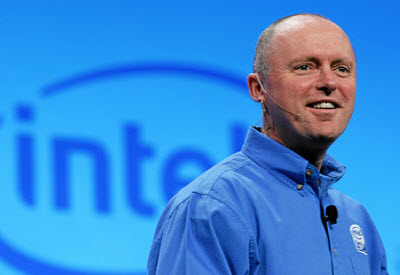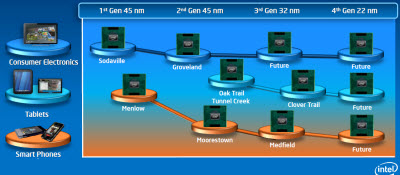 Sean Maloney, Intel‘s newly appointed president of Intel China, plans to deliver a keynote speech at the Computex trade show in Taiwan next week where he will unveil a heavy-duty effort to steer Intel into the production of low-power microprocessors.
Sean Maloney, Intel‘s newly appointed president of Intel China, plans to deliver a keynote speech at the Computex trade show in Taiwan next week where he will unveil a heavy-duty effort to steer Intel into the production of low-power microprocessors.
Maloney is expected to say that Intel will accelerate its efforts to make chips that are more appropriate for tablet computers, smartphones, laptops, and low-power desktops. Intel has been doing that for some time. But Maloney, a well-respected executive who recovered from a stroke that kept him sidelined last year, is expected to push that even farther, according to a source familiar with the matter.
This shift within Intel is similar to the shift that occurred when it launched its Centrino laptop processors in 2003 — which Intel referred to as a right-hand turn. This is another right-hand turn, since the current roadmap isn’t as ambitious when it comes to low power consumption.
Most of Intel’s mainstream desktop chips target power consumption of about 40 watts or so. That allows for very fast microprocessor performance, but such a chip generates enough heat that it can’t be so easily used in a laptop and has no chance of making it into a tablet or smartphone. Now, Intel plans to target mainstream chips that consume about 15 watts.
 That’s a big difference, but it doesn’t mean Intel will cancel a bunch of chips in development. Rather, the company will modify the roadmap over the next couple of years so that the center of its efforts focuses on 15 watt or lower wattage chips.
That’s a big difference, but it doesn’t mean Intel will cancel a bunch of chips in development. Rather, the company will modify the roadmap over the next couple of years so that the center of its efforts focuses on 15 watt or lower wattage chips.
The company has already been moving in this direction for a number of years. Intel recently announced a new manufacturing innovation dubbed Tri-Gate transistors that will allow it to use lower power and smaller circuits in its 22 nanometer microprocessors. (Intel’s current Sandy Bridge chips use 32-nanometer manufacturing; the smaller the number, the faster, lower power, and lower cost.) At its recent annual investor meeting, Intel showed a working 22-nanometer microprocessor code-named Ivy Bridge that is one of the flagship chips for this new low-power strategy. The Tri-Gate transistors take advantage of three dimensions and allow for a 50 percent power reduction at a given level of performance with only a 2 to 3 percent increase in costs. Ivy Bridge will be followed by a chip code-named Haswell that will represent the fruition of Intel’s efforts to reduce the average wattage of its mainstream chips.
 Intel is also accelerating development of its lowest-power Atom microprocessors, which are targeted at smartphones, tablets and ultrathin laptops. The Atom chips have been shipping for a number of years, but Intel will turn up the treadmill now. It will shift from 45 nanometer Atom chips this year to 32 nanometer chips and then 22-nanometer chips in 2012. With every manufacturing shift, Intel can make its chips cheaper, faster, smaller and lower power. That pace of innovation is faster than the pace of Moore’s Law (observed in 1965 by Intel chairman emeritus Gordon Moore), which says the number of transistors on a chip doubles every two years.
Intel is also accelerating development of its lowest-power Atom microprocessors, which are targeted at smartphones, tablets and ultrathin laptops. The Atom chips have been shipping for a number of years, but Intel will turn up the treadmill now. It will shift from 45 nanometer Atom chips this year to 32 nanometer chips and then 22-nanometer chips in 2012. With every manufacturing shift, Intel can make its chips cheaper, faster, smaller and lower power. That pace of innovation is faster than the pace of Moore’s Law (observed in 1965 by Intel chairman emeritus Gordon Moore), which says the number of transistors on a chip doubles every two years.
Intel is also designing a brand new Atom single-chip computer architecture, code-named Silvermont, from the ground up. Those chips are also going to be designed for low power, and the cadence for introducing new chips will become increasingly faster. The 22-nanometer Silvermont chips are expected to be introduced around 2013.
“Intel will completely focus a huge percentage of consumer microprocessors toward mainstream, low-power, ultra-thin, no-compromise computers,” said the source. “The center point of the roadmap will be all about ultra-mobility.”
By the end of 2012, a large percentage of consumer laptops will be in the ultrathin category — think MacBook Air laptops that cost a lot less than they do today and have a lot more performance and all-day battery life. That’s the kind of machine that will use the chips that Intel is placing at the center of its efforts.
Asia is a good place to make the announcement since China is expected to be the largest PC market in the world starting next year. Maloney’s assignment to that region is significant. Maloney was considered the heir apparent to Intel chief executive Paul Otellini. But a stroke threw him off that path. He returned to work in January and is regaining control of his motor skills.
Intel’s Atom processors are beginning to appear in tablet computers and about 10 of them will be shown off at the Computex show in Taiwan.

